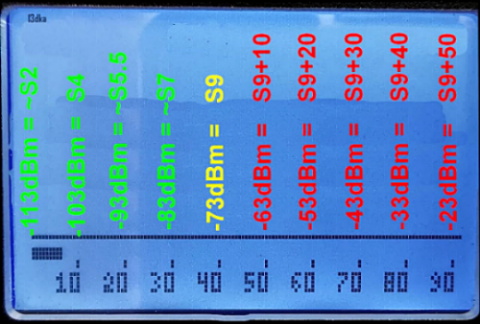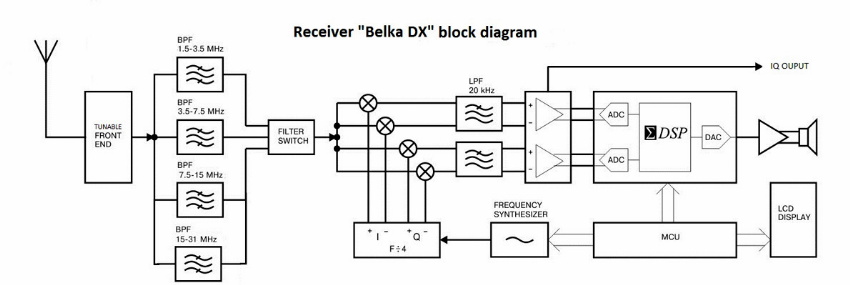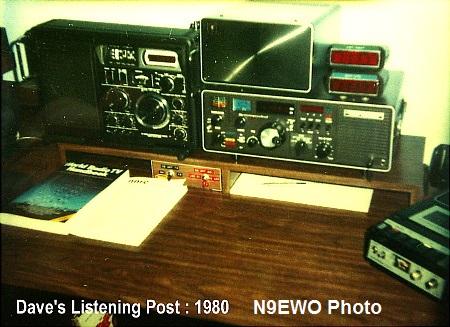Absolutely TINY size / Fair Ergonomics / Metal Case and Knob / Internal glued in Lithium Ion Type Battery.
Belka-DX size is at
a super SMALL 3.5 x 2.0 x 0.8 inches (86 x 50 x 20 mm) not including
knob and BNC antenna. Weight at 3.52 ounces (100 grams). Entirely made
in a all metal case with screws. Even the lone knob has a metal shell (plastic base).
The most disconcerting con with the Belka is the use of a lithium ion
type battery. It's a glued on pack to the inside of the rear cover.
When it comes time for replacement one has to pry off this battery to
replace it. Good luck with that as that is a extremely dangerous
procedure (if it should be attempted at all) ! We would have preferred
use of say 3 AAA Ni-Mh batteries in a holder even with a shorter run
time between charges ! By the way it's battery meter LCD icon is most
useful and accurate.
NOTE : There is an overpriced after market internal speaker option called the LSP3W that
also increases the internal battery capacity even a bit more over the
original headphone version (2200 vs 2500 mah). It also adds 2 swinging
feet for tilting the receiver. This makes the cabinet less stealthy
(not tested). Appears the availability of this product is difficult ?
USB micro jack is used for charging the internal lithium ion type
battery (sorry it's not a USB C), Current
consumption is slated at 80 ma (with headphones) which is a battery
miser
indeed. With the headphone only versions (which contain a higher
capacity
battery) operation time is like 24+ hours on a single charge. With the
speaker option installed is at around 10+ hours (smaller battery plus
the speaker use).
As can be expected with only FOUR pushbuttons on it's spartan front
panel it's ergonomics are like a trip down a side of a extremely
steep mountain in a coaster wagon. Would not say that it's totally
hostile, but is not very good either. But being what it's sheer
size is one should give time to adjust to it's operations including it's fidgety tuning encoder. However even
after some use we were still having a frustrating time overwriting
wanted memory channels (it's so easy to do that).
Front Panel Buttons (selection is made with it's single mechanical encoder knob):
VOL : Volume and Sensitivity adjustments
MOD : Mode Select / Bandwidth (high cut) / Low Cut (bass)
MODES Available : CWU, LSB , USB , AM1 (Standard AM), AM2 (Double Sideband pseudosynchronous Detection), NFM
MEM : Memory Channel Enter / Select (32 or 36 memories store frequency, sensitivity level, tuning step and mode)
PWR : Power On / Off (press and hold) / Backlight Options
ENCODER KNOB (press in) : Tuning Step (10, 20, 50, 100 hz 1K 5K, 10K, 50k), (press and hold while rotating, fast advance)
Frequency Coverage (Depends on Generation) / No FMBC / No Squelch / 32 (or 36) Memories / No Scanning
Frequency coverage varies a bit depending on what generation (version)
you are talking about.. First and second generations (versions) did not
cover the medium wave broadcast band (2nd stated at 1.5 MHz but that is
short of not). Later 3rd model covers from .1 to 31 MHz (not tested, see chart below) and also gives for 4 more memory channels.
If you need FM broadcast on portable set, the Belka does not offer that period (look elsewhere). Narrow FM MODE
is offered which is a nice touch. So one can properly tune into
CB FM, 10 meter amateur band FM stations and a crazy HF pirate that
appears once in awhile using narrow band FM mode.
Speaking of memory channels those 32 (or 36) store frequency,
sensitivity (RF Gain ?), tuning step and mode. There is no scanning or
searching of either up-down frequency or memory channels with the
Belka. When you enter a memory channel it ALWAYS starts with number 1
and forced to rotate the knob to go where you want to be for the proper
channel. He would have liked to seen say 50 or even 100 memory
channels, but of course that would have added more stress in the
ergonomic mess.
There are no preset band presets provided. So the user has to create those using the limited memory channels.
Generation (Version)
|
Frequency Coverage
MHz
|
Number of
Memory Channels |
Belka - DSP (1)
[Note : Does not support internal speaker option]
|
3.5 to 30
|
32
|
Belka - DX (2)
|
1.5 to 31
|
32
|
Belka (3)
|
0.1 to 31
|
36
|
No Internal Speaker / Internal Speaker Option Works OK / Push In - Mechanical Encoder Has Rotational Slop
Original
Belka-DSP (Generation 1) had no internal speaker period and is not
possible to install the external speaker kit in it either as it is soldered
in - hard wired. So the only way to listen to the receiver is to use a
pair of headphones / earbuds, or some external speaker hook up.
WARNING
: Be careful when plugging in any earphone / speaker (ditto for the IQ output). As covered in the
manual, one should NEVER use a mono type 2-conductor plug as that will
short out the amplifier and damage it.
We tested the internal speaker option which was in one of test samples and works
adequately in most QUIET indoor situations (so be it a bit weak at
maximum level). Outdoor use was limited not having not enough punch
so headphones or a amplified STEREO speakers had to be used.
When the external speaker option is used the battery capacity / size size is reduced
and gives for a much shorter operational time. So this is a trade off thing.
The lone mechanical rotary encoder has rotational play. That is when
you go counter clockwise rotation to clockwise there is noticeable
amount of rotational play-slop feeling. This is common with encoders
that also have a push in function (and the Belka has that to select the
tuning step). Overall it works fine,but for the record.
Direct Sampling Scheme with DSP / ROCK Stable / No Way to Update Firmware
Belka receivers
use a direct conversion quadrature scheme and DSP. With the Belka-DX
model tested there are 4 front end bandpass filters. This makes for
excellent out of band signal rejection. It can tune down to 10 hz steps
(display shows 1 hz minimum, but this for show only).
Reference oscillator uses a quality 0.5 PPM TXCO. This is unheard of in
price point of the Belka. Gives for outstanding stability and a
DEAD on frequency display.
There is no way for the user to update the firmware like with many
other SDR / DSP receivers these days. A bit of a disconcerting
bug but being operation was stable with both test samples is not as
important as it could have been.
Belka-DX "Generation 2" block diagram. The Belka was developed by Alex, EU1ME.
Direct conversion quadrature design with decent front end filtering.
Later "Belka" model adds one extra front end bandpass filter for 0.1 to 1.5 MHz.
Superb Sensitivity / Selectivity / Stability / Audio Quality / BNC
Antenna Connector / High Impedance Antenna Input ? / AGC
Belka is excellent
on all performance bases. Sensitivity is simply breath taking even with it's
with included short included whip. However being the case is all metal,
body hand capacitance can greatly affect whip reception (but not always). If you just set
it on the table and no longer touch it sensitivity can take a take a big dive. One needs to add a
counterpoise of some kind say adding a wire to the ground side of the
BNC. Just using a long headphone cable does the trick nicely too
(provided you are listening with headphones that is).
Ditto with selectivity, first rate. A number of well chosen bandwidths
are provided. As with many DSP based receivers In AM mode they sound
wider than listed. So the 4 kHz widest filter sounds like 8 kHz (which
is preferable for our wider filter desires).
Bandwidths Available on Belka-DX Test Samples (see text):
USB, LSB, AM1, AM2, NFM : 2k, 2.4k, 2.7k, 3k, 4k hz
CW U : 200, 600, 700, 900 and 1k hz
Yes, a desirable BNC antenna
socket is used. This is much more robust
over over any SMA type. However it's of a high impedance input only. So
is suggested to add a resistor and capacitor as indicated in later
owners manuals
for proper matching when using say a low impedance
dipole external antennas. This is not absolute as it will function
without these parts and in practice we did not notice much difference
here using 50~75 ohm outdoor antennas.
All Belka's have a high impedance antenna input. While perfect for whip and long wire antenna's,
this is not proper for use with dipoles and other low-Z types. Later owner manuals
indicate to add a resistor and capacitor for proper matching (see text above).
Audio quality is another home run. Absolutely with no bug-a-boos or
hiss nasties and AGC clipping does not exist in SSB / ECSS modes
(clean). AGC is near excellent even if lacking any decay rate adjustments
and even a bit too fast (all modes). A low cut off adjustment is also
provided in the bandwidth screen but most will just leave this at it's
minimum low level. This will be dependent on headphones / external
speaker used.
We need to give credit again to it's rock solid
stability with a display that is dead on accurate across the
entire tuning range. So no need for those unhandy "pain in the rump"
calibration and
non linear setting schemes found with Chinese sets to offset bad
engineering. ECSS is excellent with the Belka with it's dead on
frequency display and rock solid stability (oh yes the decent AGC
performance in the mix too).
"pseudosynchronous detection" Improves Most Signals, But What Actually Is It ? / Accurate Signal Meter But No S-Unit Scale
AM2 mode on the Belka is marked as "pseudosynchronous detection" (what the #&!! is that). In our testing it appears to be another type of synchrophase detector type circuit
(in double sideband). Mind you it helps a bit with fading distortion
and pulling a signal out of the noise. But it is clearly NOT a true Synchronous
Detector.
One AM2 grumble was with SOME WEAK signals that contained severe fading
/ flutter, in this case it was best to leave
it in AM1 (standard AM detection) or use ECSS as these signals tended
to get washed out. Anyway it is useful and desirable to leave on with
most (but not all) AM
mode signals in our testing.
Belka's have a most accurate signal strength bar type meter. However no
standard S-Unit scale is provided. Photo below of a conversion handy chart as posted on SWLing.com developed by 13dka.

Belka's bar type signal strength is most accurate. However it lacks a S-Unit scale.
"13dka" provides a handy conversion scale (as posted on SWLing.com).
Dynamic Range Decent / Sensitivity Control / Spurious Signals
Dynamic range is
decent. Overloading was not detected even when connected to decent
outdoor antennas at peak listening time (say on 49 meter SWBC at
night). Thankfully a sensitivity adjustment (volume control button on
second press) is provided to fix that issue if swamped say by a local amateur radio operator or such.
We never detected excessive spurious signals in testing.
Availability ? / How does one purchase a Belka Receiver ?
The Belka receivers (now generation 3 only, not tested) can be purchased direct from the manufacture in Belarus here. Or an alternative dealer Mobimax via Bulgaria.
However is more expensive here but perhaps a bit more stable with
worldwide events as they are these days. In any event availability
could be indifferent at times. These are the only 2 places to order a
Belka at the time this report was complied.
Best Micro Portable Ever Tested - If not one of the Better Portables ever tested for Performance !
While most
portables can also be used comfortability at home using external
antenna's / AC adapters, the Belka sets are simply not well suited for that
purpose for hour after hour listening sitting at a desk. It's just too tiny with it's
struggling ergonomics. However if you need the ultimate portable
with excellent performance for the backyard or camping, this is clearly the best MICRO-Small set we have ever tested.
Yes even when compared to the bit larger Sony ICF-SW100 (also
previously tested). However using a glued in lithium ion type battery
is very disconcerting and wish that say 3 common AAA removable
nickel-metal-hydride cells in a battery holder were used instead even
if shorter operating time. WARNING (once again) : If one replaces that battery, it's an extremely dangerous and risky operation when "prying" the old one out.
We found overall performance of the Belka-DX greatly excels over ANY of the Chinese
receivers we have tested to date (only exception is the Tecsun Grundig
Satellit 800). A breath of fresh air indeed. It's like having a super tiny high performance communications receiver in your
pocket / hand. Just be prepared to get accustomed to the fidgety
tuning encoder and poor ergonomics. However the price is much more than say a Tecsun PL-330 or
PL-365 and that has to be considered with any decision
to purchase one (along with possible availability issues).


